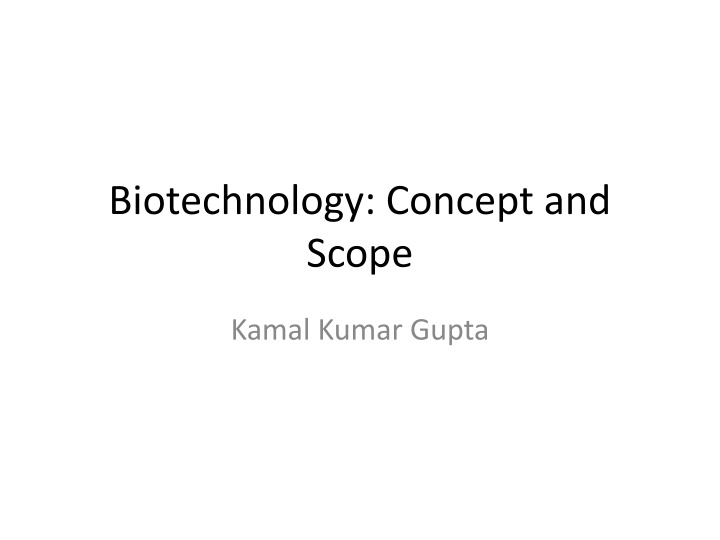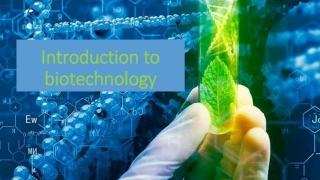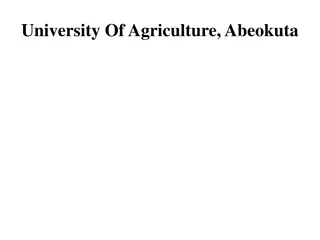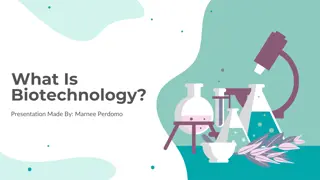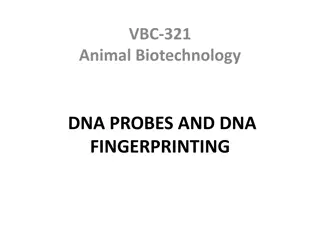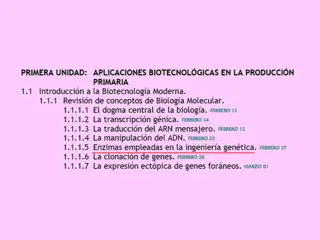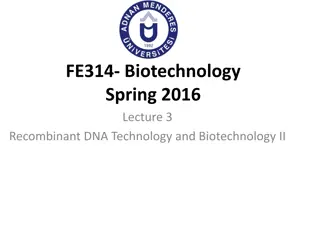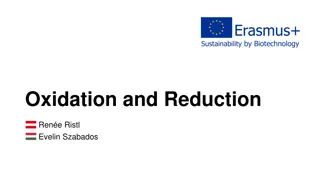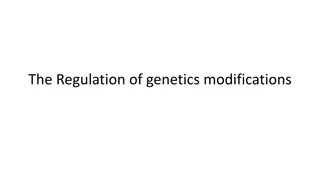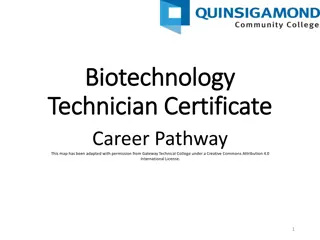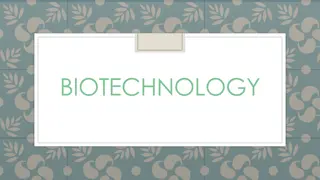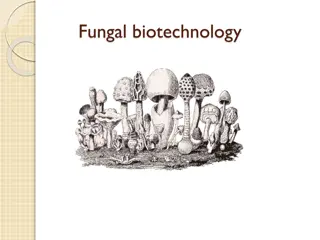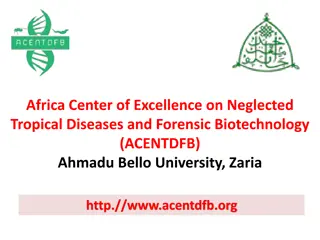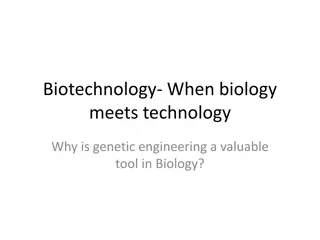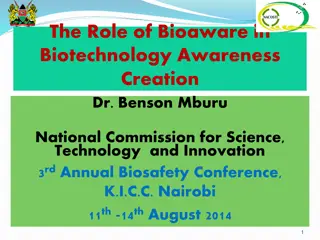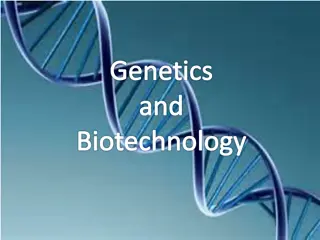Insights into Biotechnology: Concepts and Applications
Biotechnology involves the application of scientific and engineering principles to utilize biological agents for producing goods and services. The field encompasses processes like upstream processing, fermentation, and downstream processing to create valuable compounds. Initially, efforts focused on enhancing product yields through mutation, leading to the development of improved microbial strains and innovative products. Molecular biotechnology further advances by manipulating genes to produce beneficial outcomes.
Download Presentation

Please find below an Image/Link to download the presentation.
The content on the website is provided AS IS for your information and personal use only. It may not be sold, licensed, or shared on other websites without obtaining consent from the author.If you encounter any issues during the download, it is possible that the publisher has removed the file from their server.
You are allowed to download the files provided on this website for personal or commercial use, subject to the condition that they are used lawfully. All files are the property of their respective owners.
The content on the website is provided AS IS for your information and personal use only. It may not be sold, licensed, or shared on other websites without obtaining consent from the author.
E N D
Presentation Transcript
Biotechnology: Concept and Scope Kamal Kumar Gupta
Biotechnology -Definition The application of scientific and engineering principles to the processing of material by biological agents to provide goods and services The industrial production of goods and services by processes organisms, systems, and processes, using biological
Karl Ereky Karl Ereky, a Hungarian engineer, coined the term biotechnology in 1917 He described an integrated process for the large-scale production of pigs by using sugar beets as the source of food
Principal steps of a bioengineered biotechnology process Upstream processing: Preparation of the microorganism and the raw materials required for the microorganism to grow and produce the desired product Fermentation and transformation: Growth (fermentation) of the target Microorganism in a large bioreactor (usually >100 liters) with the consequent production (biotransformation) of a desired compound, which can be, for example, an antibiotic, an amino acid, or a protein Downstream processing: Purification of the desired compound from either the cell medium or the cell mass
Initial efforts to enhance product yields focused on creating variants (mutants) by using chemical mutagens or ultraviolet radiation to induce changes in the genetic constitution of existing strains. However, the level of improvement that could be achieved in this way was usually limited biologically. If a mutated strain, for example, synthesized too much of a compound, other metabolic functions often were impaired, thereby causing the strain s growth during large-scale fermentation to be less than desired. Despite this constraint, the traditional induced mutagenesis and selection strategies of strain improvement were extremely successful for a number of processes, such as the production of antibiotics
Improvement of the Microbial strain Development of useful and improved biological products and processes and to create new products that would not otherwise occur.
Molecular Biotechnology Methods manipulation of genes for the purpose of producing useful goods and services using living organisms is known as molecular biotechnology. The pivotal development that enabled this technology was the techniques to isolate genes and to transfer them from one organism to another require knowledge of and establishment of
Recombinant DNA Technology The technology began as a lunch time conversation at a scientific conference in 1973. Stanley Cohen, University in California: had been developing methods to transfer plasmids, circular DNA molecules, into bacterial cells. Herbert Boyer, University of California at San Francisco: was working with enzymes that cut DNA at specific nucleotide sequences. Stanford small
Recombinant DNA Technology Over lunch at a scientific meeting, they reasoned that Boyer s enzyme could be used to splice a specific segment of DNA into a plasmid and then the recombinant plasmid could be introduced into a host bacterium using Cohen s method.
Commercialization of Molecular Biotechnology The potential of recombinant DNA technology reached the public with a frenzy of excitement, and many people became rich on its promise. Indeed, within 20 minutes of the start of trading on the New York Stock Exchange on 14 October 1980, the price of shares in Genentech, the company, founded by Cohen and Boyer with chemist and entrepreneur Robert Swanson, that produced recombinant human insulin, went from $35 to $89. This was the fastest increase in the value of any initial public offering in the history of the market.
Insulin: First commercial product from DNA Technology The first commercial product produced using recombinant DNA technology was human insulin, which is used in the treatment of diabetes. The DNA sequence that encodes human insulin was synthesized, It was transplanted into a plasmid that could be maintained in the common bacterium Escherichia coli. The bacterial host cells acted as biological factories for the production of the two peptide chains of human insulin These are combined, purified and used to treat diabetics who were allergic to the commercially available porcine (pig) insulin.
Many scientific disciplines contribute to molecular biotechnology, which generates a wide range of commercial products
Molecular biotechnology use knowledge from a diverse set of fundamental scientific disciplines to create commercial products that are useful in a wide range of applications The biotechnology component was perfected by industrial microbiologists and chemical engineers, The recombinant DNA technology portion is an outcome of discoveries in molecular biology, bacterial genetics, and nucleic acid enzymology
Advantage of Molecular Biotechnology Genetic engineering provided the means to create, rather than merely isolate, highly productive strains. Bacteria and eukaryotic cells were used for the production of insulin, interferon, growth hormone, viral antigens, and a variety of other therapeutic proteins. Recombinant DNA technology could also be used to facilitate the biological production of large amounts of useful low-molecular-weight macromolecules that occur naturally in minuscule quantities. compounds and
Advantage of Molecular Biotechnology Plants and animals became targets to act as natural bioreactors for producing new or altered gene products that could never have been created either by mutagenesis and selection or by crossbreeding. Molecular biotechnology has become the standard method for developing living systems with novel functions and capabilities for the synthesis of important commercial products.
Thrust areas Development of technologies Agriculture and agro based industries Food security Health Environment
Development of large variety of experimental protocols that made identifying, isolating, characterizing, and utilizing genes more efficient and relatively easy
These technological developments have had an enormous impact on generating new knowledge in practically all biological disciplines, including Animal behavior, Developmental biology, Molecular evolution, cell biology, Human genetics. Indeed, the emergence of the field of genomics was dependent on the ability to clone large fragments of DNA into plasmids in preparation for sequence determination
In the 25 years since the commercial production of recombinant human insulin, more than 200 new drugs produced by recombinant DNA technology have been used to treat over 300 million people for diseases such as cancer, multiple sclerosis, cystic fibrosis, and strokes and to provide protection against infectious diseases. Over 400 new drugs are in the process of being tested in human trials to treat Alzheimer disease and heart disease.
Similarly, many new molecular biotechnology products for enhancing crop and livestock yields, decreasing improving industrial processes, such as the manufacture of pulp and paper, food, energy, and textiles, have been created and are being marketed. pesticide use, and
Commercialization of Molecular Biotechnology Organisms with novel genetic constitutions could be readily created. It was predicted that some genetically engineered microorganisms would replace chemical fertilizers and others Would eat up oil spills, Plants with inherited resistance to a variety of pests and exceptional nutritional content would be created, Livestock would have faster growing times, more efficient feed utilization, Meat with low fat content.
Commercialization of Molecular Biotechnology Today we see that, despite the commercial hype that dominated reality in the beginning, this infatuation with recombinant DNA technology was not totally unfounded. A number of the more sensible versions of the initial claims, although trimmed in scope, have become realities.
